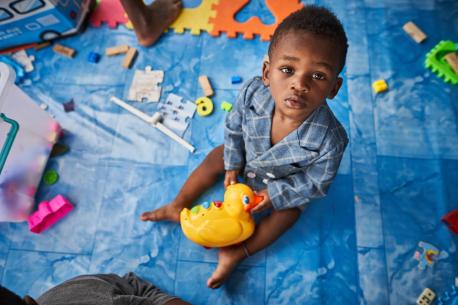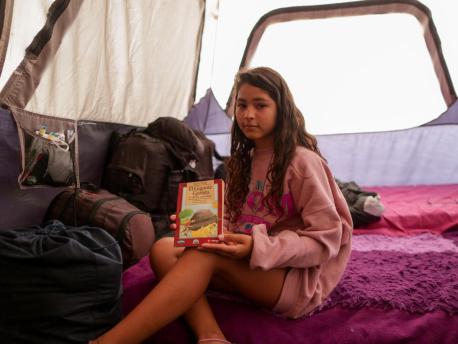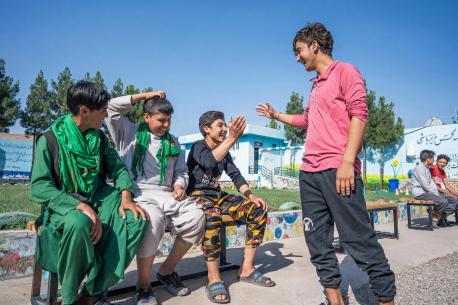
UNICEF in Latin America and the Caribbean
A look at some of the ways UNICEF is working with its partners across the Latin America and Caribbean region to improve the lives of child migrants and other vulnerable children and to ensure their rights are protected.
The humanitarian needs in a number of countries in the Latin America and Caribbean region have intensified — fueling migration flows — as situations for more and more children and families have become increasingly desperate. This is due to a number of factors, ranging from gang violence to poverty to the deep and lingering socioeconomic impacts of the COVID-19 pandemic.
UNICEF's mission in the region reflects the urgency of these overlapping crises. Humanitarian action plans cut across all major program areas in order to meet the needs of the most vulnerable, while also helping to tackle some of the root causes of migration.

Three-month-old Jean Louis is held by a UNICEF staff member at a site for children and families displaced by gang violence in Croix-des-Missions outside Port-au-Prince. UNICEF and partners are working to address the needs of the displaced, providing services including psychosocial support. © UNICEF/UN0632308/
With increasing migration from Central America and Mexico to the United States, there are an estimated 1.2 million children from both migrant families and host communities requiring humanitarian aid. Difficult conditions in Venezuela have prompted large numbers of families with children to migrate across the region, leaving an estimated 2 million children from Venezuela and in host communities in need of assistance.
In Haiti, the situation for children has become increasingly complex due to a number of factors, including the effects of the August 2021 earthquake, the COVID-19 pandemic, ongoing political and social turmoil and a surge in urban violence. There is internal displacement, migration across borders and also migrants being returned, all developments that have increased humanitarian needs in the country.
Humanitarian aid for children on the move
UNICEF continues to partner with local organizations, governments and authorities in the region to provide essential support for vulnerable children and families, especially for uprooted children.
This includes an increasing number of children making the treacherous journey through the Darien Gap, a stretch of jungle terrain that straddles Colombia and Panama. A grueling 10-day crossing, which can only be made on foot, is considered one of the most dangerous migration routes in the world.
The health and safety risks are especially high for migrant children who make the journey. There are rivers with strong currents. Wild animals. Insects. Extreme heat and humidity. The presence of armed gangs in the Gap also expose children to risks of violence and exploitation, including sexual abuse, trafficking and extortion.

Sanaicar, 5, foreground, draws alongside Neldaisha, 4, in a safe space set up by UNICEF and a local partner in Metetí, Darien, Panama, known as "La Casita" (the small house). Both girls arrived in Panama as unaccompanied children, having journeyed through the Darien Gap. They were reunited with their families within days with help from UNICEF and Panamanian authorities. © UNICEF/UN0560343/Urdaneta
Yet more and more people are choosing those risks over the difficult conditions and hardships — including a lack of sustainable economic opportunities — at home. Racism and discrimination against migrants in other destination and transit countries is another factor.
The total number of those who migrated through the Darien Gap in 2021 is five times more than the four previous years combined. Three out of four young migrants are under age 5 — many of them children of Haitian migrants who have been on the move for years, having left Haiti following the earthquake in 2010, and living for a time in Brazil or Chile.
Providing WASH and other lifesaving services to migrants arriving in Darien, Panama
UNICEF is working with partners to meet urgent needs of migrant children and families arriving in Panama, providing clean water, nutrition and health care, and setting up Child-Friendly Spaces where children can learn and play and receive psychosocial support.
Delrin Chavarria is a UNICEF Panama WASH Specialist who left Nicaragua at age 12 in search of a better future. His job is to works to maintain and create a system to make water drinkable for migrants in Darien.
"The people, especially the children, arrive here exhausted, without strength, sick after so many days in the jungle, barely eating, and drinking contaminated water from the rivers," Chavarria says. "They need drinking water, attention, to be received with some humanity."
Children arrive here exhausted, without strength, sick after so many days in the jungle, barely eating, and drinking contaminated water from the rivers. They need drinking water, attention, to be received with some humanity.
UNICEF is also working with local authorities on the Colombian side of the border to identify unaccompanied and separated children through mobile units and provide protection services.

A girl who made it through the Darien Gap is helped onto a boat in the indigenous community of Bajo Chiquito, the first entry point in Panama. This "pangas" will take her and other migrants to the next point north, where clean water and other support is being provided by UNICEF and partners. Every month, thousands of families risk their lives in this dangerous journey searching for a better future. © UNICEF/UN0559507/Urdaneta
Other UNICEF-supported regional programs focused on child protection, nutrition and education include:
- A regional communication campaign to improve child protection: In May 2022, UNICEF launched a campaign called “Unaccompanied Footsteps” to raise awareness of the risks unaccompanied refugee and migrant children and adolescents in Latin America face. The goal is to promote changes that improve protection for unaccompanied children and inform migrants of the services available in their journey and host countries. The campaign is also meant to raise awareness among decision makers in these countries about the risks children are forced to take and what they need.
- Catch-up classes for students who fall behind on their education due to school closures, displacement and other disruptions: An acceleration program in Ecuador helps students make up for school time lost during the COVID-19 pandemic by offering an integrated learning curriculum, which condenses three years of schooling into one. The approach has been shown to help prevent students from dropping out of school entirely. Nearly 4,500 students in Ecuador have resumed their education through this program.

Romina, 14, performs a math exercise while attending classes at the El Giron school in Manta, Manabí, Ecuador, as part of a UNICEF-supported accelerated learning program. © UNICEF/UN0617978/
- Filling the learning gap for children impacted by gang violence in Haiti: A surge in gang violence in April in and around Port-au-Prince displaced hundreds of Haitian families and also forced nearly 1,700 schools to close, shutting classroom doors for half a million children. UNICEF and partners are preparing to launch a dedicated FM station to provide daily lessons to children over the radio; in the meantime, the program is being delivered over Haiti national radio, enabling children to continue studying remotely.
- Fighting malnutrition in Venezuela: Together with partners, UNICEF screens children for acute malnutrition and provides overall health and nutrition support. Services include providing nutritional supplements to improve immunity and deworming tablets to treat intestinal worms. Pregnant and breastfeeding women also received counseling on breastfeeding and best sanitation and hygiene practices.
Learn more about UNICEF's work in the Latin America and Caribbean region.
Support UNICEF's mission to deliver lifesaving aid to vulnerable children and to ensure their rights are protected. Donate today.
Top photo: A boy plays in a UNICEF Child-Friendly Space set up for migrant children in Lajas Blancas, Darien, Panama. The number of migrant children and families making the dangerous journey through the Darien Gap between Colombia and Panama has surged due to a factors, prompting UNICEF to respond with support across most major program areas. © UNICEF/UN0560323/Urdaneta
HOW TO HELP
There are many ways to make a difference
War, famine, poverty, natural disasters — threats to the world's children keep coming. But UNICEF won't stop working to keep children healthy and safe.
UNICEF works in over 190 countries and territories — more places than any other children's organization. UNICEF has the world's largest humanitarian warehouse and, when disaster strikes, can get supplies almost anywhere within 72 hours. Constantly innovating, always advocating for a better world for children, UNICEF works to ensure that every child can grow up healthy, educated, protected and respected.
Would you like to help give all children the opportunity to reach their full potential? There are many ways to get involved.




